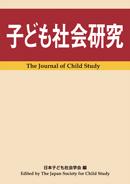Current issue
Displaying 1-25 of 25 articles from this issue
- |<
- <
- 1
- >
- >|
-
2025Volume 31 Pages 1-2
Published: June 30, 2025
Released on J-STAGE: June 30, 2025
Download PDF (175K) -
2025Volume 31 Pages 3-15
Published: June 30, 2025
Released on J-STAGE: June 30, 2025
Download PDF (935K) -
2025Volume 31 Pages 17-29
Published: June 30, 2025
Released on J-STAGE: June 30, 2025
Download PDF (499K) -
2025Volume 31 Pages 31-44
Published: June 30, 2025
Released on J-STAGE: June 30, 2025
Download PDF (524K)
-
2025Volume 31 Pages 45-46
Published: June 30, 2025
Released on J-STAGE: June 30, 2025
Download PDF (138K) -
2025Volume 31 Pages 47-60
Published: June 30, 2025
Released on J-STAGE: June 30, 2025
Download PDF (1825K) -
2025Volume 31 Pages 61-72
Published: June 30, 2025
Released on J-STAGE: June 30, 2025
Download PDF (1606K) -
2025Volume 31 Pages 73-84
Published: June 30, 2025
Released on J-STAGE: June 30, 2025
Download PDF (1501K) -
2025Volume 31 Pages 85-93
Published: June 30, 2025
Released on J-STAGE: June 30, 2025
Download PDF (371K)
-
2025Volume 31 Pages 95-109
Published: June 30, 2025
Released on J-STAGE: June 30, 2025
Download PDF (609K) -
2025Volume 31 Pages 111-125
Published: June 30, 2025
Released on J-STAGE: June 30, 2025
Download PDF (844K) -
2025Volume 31 Pages 127-141
Published: June 30, 2025
Released on J-STAGE: June 30, 2025
Download PDF (636K) -
2025Volume 31 Pages 143-157
Published: June 30, 2025
Released on J-STAGE: June 30, 2025
Download PDF (533K) -
2025Volume 31 Pages 159-174
Published: June 30, 2025
Released on J-STAGE: June 30, 2025
Download PDF (673K) -
2025Volume 31 Pages 175-191
Published: June 30, 2025
Released on J-STAGE: June 30, 2025
Download PDF (703K) -
2025Volume 31 Pages 193-207
Published: June 30, 2025
Released on J-STAGE: June 30, 2025
Download PDF (719K) -
2025Volume 31 Pages 209-224
Published: June 30, 2025
Released on J-STAGE: June 30, 2025
Download PDF (576K) -
2025Volume 31 Pages 225-240
Published: June 30, 2025
Released on J-STAGE: June 30, 2025
Download PDF (654K) -
2025Volume 31 Pages 241-256
Published: June 30, 2025
Released on J-STAGE: June 30, 2025
Download PDF (625K)
-
2025Volume 31 Pages 257-269
Published: June 30, 2025
Released on J-STAGE: June 30, 2025
Download PDF (512K)
-
2025Volume 31 Pages 271-273
Published: June 30, 2025
Released on J-STAGE: June 30, 2025
Download PDF (221K) -
2025Volume 31 Pages 275-277
Published: June 30, 2025
Released on J-STAGE: June 30, 2025
Download PDF (226K) -
2025Volume 31 Pages 279-281
Published: June 30, 2025
Released on J-STAGE: June 30, 2025
Download PDF (233K) -
2025Volume 31 Pages 283-285
Published: June 30, 2025
Released on J-STAGE: June 30, 2025
Download PDF (180K)
-
2025Volume 31 Pages 287-289
Published: June 30, 2025
Released on J-STAGE: June 30, 2025
Download PDF (229K)
- |<
- <
- 1
- >
- >|
